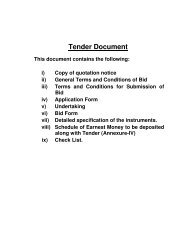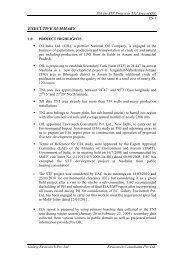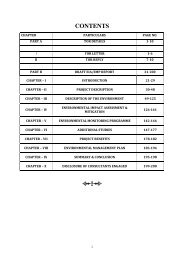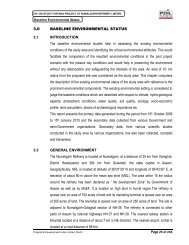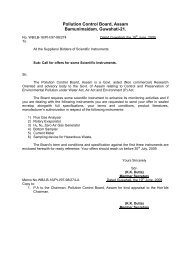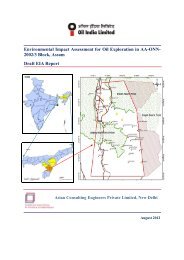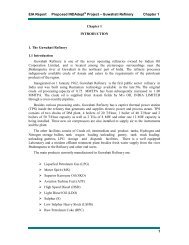ChapterIII(a) - Pollution Control Board, Assam
ChapterIII(a) - Pollution Control Board, Assam
ChapterIII(a) - Pollution Control Board, Assam
Create successful ePaper yourself
Turn your PDF publications into a flip-book with our unique Google optimized e-Paper software.
EIA Report Proposed INDAdept G Project – Guwahati Refinery Chapter 3PROPOSAL OF DEVELOPMENTENVIRONMENTALIMPACT ASSESSMENTECONOMICASSESSMENTSOCIALASSESSMENTAre the impactsacceptable?Does it make economic sense?Are the consequencessocially acceptable?DECISION ABOUT THE DEVELOPMENTFig. 3.1: The role of EIA in the decision-making processThe analytical aspects involve the methods and the techniques that are required to collectthe relevant data, to identify the environmental impacts, to assess the significance of suchimpacts, to propose impact mitigation measures, etc. Such methods and techniques have beenproposed by academics, experts and practitioners and are described in the scientific literature,and usually collected in guidelines, handbooks, etc.The procedural aspects define the position of EIA within the overall decision makingprocess concerning the authorization of a project. They specify, for instance, the role assignedto the project developer and the public authorities, the time constraints to be respected, etc.The procedure of EIA is regulated by legislation, and consequently it is generally different fordifferent countries, or even between regions of the same country. EIA first appeared in anational legislation in the USA in 1969 (National Environmental Policy Act). Ever since, ithas found its way in the legislation of many countries, within both the industrial and thedeveloping regions of the world. In the European Union, EIA was introduced by the Directive85/337 (CEC 1985) and it is currently regulated by the amending Directive 97/11 (CEC1997).Despite the different legal prescriptions around the world, EIA consists of a ratherstandard set of logically organized stages (Fig. 3.2) that lead to the generation of a formaldocument, the Environmental Impact Statement (EIS).As per the guidelines of the Ministry of Environment and Forests, Government of India,the EIA is defined as the following:22
EIA Report Proposed INDAdept G Project – Guwahati Refinery Chapter 3The description of the actual (i.e., pre-project) environmental status provided by thebaseline study serves to set a reference for the subsequent impact analysis. Moreover, it helpsdecision-makers and EIA reviewers to become familiar with the environmental features andthe needs of the study area. The baseline study, as well as the subsequent stages of impactprediction, assessment and mitigation, is done a group of experts on behalf of the projectproponent.Rapid EIA is carried out through the collection of ‘one season’ (other than monsoon) data asper the Ministry of Environment and Forests guidelines in order that the time required fordecision-making for a proposed project may be considerably reduced. The rapid EIA Studyincludes(i)(ii)collection of detailed information on the existing environment or ‘baseline data’andestimation of the related data of the proposed activities i.e. ‘project data’ or ‘plaindata’.The project data are then superimposed on the baseline data and the resultantenvironmental impacts are predicted with the help of various tools. This rapid EIA study, asthe name implies, is a rapid estimation of the prevalent environmental scenario and/or anassessment of the impacts, if any, which are likely to occur upon execution of the proposedproject.The major environmental features studied in this EIA study are:a) Land use patternb) Surface and ground water quality, and soil quality with respect to variousPhysico-chemical characteristics,c) Meteorological parameters such as temperature, humidity, rainfall, wind speed,etc.,d) Ambient air quality,e) Noise,f) Terrestrial and aquatic ecology, andg) Demography and socioeconomic situation.The EIA Report presented here covers all the above aspects. The Report is based on the fielddata generated over a three month period following standard procedure as prescribed by theregulating agencies such as the Ministry of Environment and Forests, Central <strong>Pollution</strong><strong>Control</strong> <strong>Board</strong>, etc. A large amount of secondary data collected from various agencies wasused to supplement the field data.24
EIA Report Proposed INDAdept G Project – Guwahati Refinery Chapter 3The corridor towards west is a rail-road corridor linking not only Guwahati but also otherparts of NER, east of Guwahati to western <strong>Assam</strong> and to the mainland India. The corridorlinks residential and historically important areas such as Nilachal Hill (Kamakhya), Pandu,Maligaon (headquarters of Northeast Frontier Railways) and separates into two - one towardsNorth Guwahati and the other one towards further west to the LGB International Airport viathe University of Gauhati (Jalukbari). There are also many river ports/jetties along thiscorridor.Fig. 3.3. Urban structure of GuwahatiThe third major corridor is towards east (around 15 km from the city-center) linkingNoonmati (Guwahati Oil Refinary) and Narengi. The corridor facilitates residential growthtowards east.Moreover, the bypass of NH 37 encircling the city's southern parts linking the westerncorridor in Jalukbari and the southern corridor in Nomile is currently supporting rapiddevelopment along it. Similarly the VIP Road linking Zoo Road and the eastern corridor andrecently completed Hengerabari-Narengi Road as planned in the older master plan are alsosupporting massive residential development in the east.In brief, the major components of Guwahati's urban structure are:‣ The core with Pan Bazaar, Paltan Bazaar, Fansi Bazaar and Ujan Bazaar26
EIA Report Proposed INDAdept G Project – Guwahati Refinery Chapter 3‣ The extended core with Chandmari, Zoo Road and Ulubari‣ The north-southeast Guwahati-Shillong (GS) Road Corridor‣ The southern sub-center of Ganeshguri‣ The western corridor towards Kamakhya, Jalukbari and LGBI Airport and‣ The eastern corridor towards Noonmati and NarengiDemographyDemographically Guwahati is one of the most rapidly growing cities in India. The city'spopulation grew from just two-hundred thousand in 1971 to more than five-hundred thousandin 1991 and in the census of 2001 the city's population was found to be 808,021. It isestimated that Guwahati is already a million plus city.In 2001, males constituted 55 percent while the females at 45 percent. It was found that 10percent of the population is under 6 years of age. Guwahati has an average literacy rate of 78percent with a male literacy at 81 and female at 74 percent.Income generation and economic activitiesSeparate income estimates for the city are yet not available as city-level income estimationis not a traditional practice in India and is not practiced in a systematic and continual manner.But looking at the agglomeration of activities and employment patterns it can be easilyunderstandable that the city contributes a lions share of the state's income.The major economic activities are trade and commerce, transportation and services.Guwahati is the most important trade hub in NER. It is a major wholesale distribution center,a marketing hub and also a retail hub in the region. The Guwahati Tea Auction Centre is oneof the largest in the world. As in other cities, 'mall culture' is slowly invading Guwahati.Manufacturing is also an important activity although it is not comparable to those of India'srapidly growing industrial cities. The most important manufacturing industry in the city is thepetroleum refinery of IOCL at Noonmati. The city is also the head quarter or the seat forregional offices for several manufacturing and business establishments, e.g. NumaligarhRefinery Limited (NRL). Guwahati is also important for printing and publishing andbusinesses related to electronic and print media. During past two decades, businesses such asreal estate development, finance, etc. are also intensifying.Tourism and recreation, education, research, cultural activities, etc. are also slowlyincreasing and are contributing to city's economy.Quality of lifeAlthough being a medium sized city ranking around at 50th position (in terms ofpopulation) in India, city's quality of life is comparatively higher. A recent survey (2006) by apopular Indian magazine has ranked Guwahati at 17th among all the major and medium sizedIndian cities. The city provides competitive residential and working environments withbeautiful landscapes, pleasant climate, modern shopping areas, modern apartments andbungalows and considerably good social infrastructure. But infrastructure in the city requiresextensive attention, which can increase and revolutionize city's reputation, investmentenvironment and overall growth pattern.Major investments in infrastructure are being planned in the city covering many aspects ofutility and transport infrastructures with financial assistance from Asian Development Bank(ADB). City is also to receive substantial development funds from JNURM (Jawaharlal27
EIA Report Proposed INDAdept G Project – Guwahati Refinery Chapter 3Nehru Urban Renewal Mission)- the Government of India's recently conceived mission forurban development. A city development plan has been recently finalized for the city.Utility and transport infrastructureThe city suffers from lack of utility infrastructure. Existing water supply system isinadequate. It mostly is dependent on ground water resources (higher water level). It also doesnot have a comprehensive underground sewerage system. Septic tanks at individual housesare popular. The storm drainage system is comparatively good, although many areasexperience water logging due to heavy rainfall in the monsoon. Extensive soil erosion fromthe hillocks and clogging of the drainage system is frequent and expensive for the city. Solidwaste is being managed by the local authority with private partners. It lacks modernequipment, methods and practices.Lack of sufficient road space is also a major problem. The length of surfaced road withinthe city is presently 218 km (ARSAC). The major corridor roads suffer from insufficient rightof way, illegal construction and improper planning and design. The roads in the residentialneighborhoods are extremely narrow (lack of proper regulations) causing problems related toboth traffic and infrastructure installations. Cul-de-sacs are neither planned nor designedproperly.Guwahati has a good public transport system. A government agency - ASTC (<strong>Assam</strong> StateTransport Corporation) and many private operators provide a considerably good city-bussystem. It requires further modernization and integration with city planning and managementinitiatives. Besides these, Guwahati is the first city in northeast where low floored buses wereintroduced.Guwahati's airport, known as Lokopriya Gopinath Bordoloi International Airport, issituated in Borjhar about 20 km west of the city. Air connectivity has improved considerablyin the last couple of years and all major domestic airlines fly into Guwahati. Guwahati airportaverages about 20 arrivals and departures a day.Guwahati has three railway stations serving it. Its major station is Guwahati Junction.Two minor stations are at Kamakhya and New Guwahati located towards west and eastrespectively. Major trains serving Guwahati are Guwahati Rajdhani Express, SaraighatExpress, North-East Express, Guwahati-Jorhat Town Jan Shatabdi Express.Educational and health infrastructureThe city has Gauhati University in Jalukbari. The century old Cotton College is one of themost reputed colleges in eastern India and possesses great scholastic and cultural values. TheIndian Institute of Technology Guwahati is the recent addition to the high-profile world'srenowned IITs in India. Within a very short period of time, Guwahati IIT is proving itself asan excellent institution for research and education and its ranking among the IITs in India isincreasing every year.The <strong>Assam</strong> Engineering College and the Gauhati Medical College and Hospital are thetwo important institutions for science and technology and medical education. Among thecity's many other institutions of higher learning, Gauhati Commerce College, College ofVeterinary Science, Government Ayurvedic College, Arya Vidyapeeth College, B. BorooahCollege, Handique Girls College, <strong>Assam</strong> Engineering Institute (engineering diploma courses),Pandu College, LCB College, West Guwahati Commerce College, etc. are well known.The city is an important center for health facilities in eastern India. Many government andprivate specialty hospitals are available. The most important are the Guwahati MedicalCollege and Hospital, Guwahati Neurological Research Centre (GNRC), Down Town28
EIA Report Proposed INDAdept G Project – Guwahati Refinery Chapter 3Hospital, B. Baruah Cancer Institute, Sankardev Netralaya, etc. Medical education andresearch are also important activities.3.3.3. The study areaThe study area is the 10 km buffer around Guwahati refinery situated at Noonmati. Thestudy area covers a large part of Guwahati city with some parts of North Guwahati area on thenorth bank of the Brahmaputra River. The area is under Kamrup (Metro) District, <strong>Assam</strong>. Thearea is included in the Survey of India Toposheets 78 N/12 and 78 N/16. The area is a northeasternextension of Pre-cambrian Shillong plateau and is divided into two parts by theBrahmaputra River. The total area covered by the study area is ~314 sq km. The Suklaguriarea in North bank of Brahmaputra marks the northern limit of the study area while theBasistha Temple limits the southern boundary. The area Panikhaiti near Chandrapur lies onthe eastern most side and the Nilachal Hill (Kamakhya temple) marks the western boundaryof the entire study area. The database used in this study is given below. The location map ofthe study area is presented in Fig. 3.4.Year Data type Scale/Resolution1967 SoI Topomap 1:500002010 IRS-P6 LISS III 23.5mFig. 3.4. Location map of the study area29
EIA Report Proposed INDAdept G Project – Guwahati Refinery Chapter 33.3.4. Landuse and landcover of the areaRemote sensing and Geographic Information System (GIS) provides an effective tool forthe Land-use and Land-cover study of the area. It gives valuable information on the forestcover, vegetation, anthropogenic changes in the various land uses and land covers. Guwahaticity is mostly covered by human settlements. The city is situated on an undulating plain withvarying altitudes above the mean sea level.In this study, the entire study area is classified on the following Land-use Land-cover(LULC) classes(a) River(b) Sandbar(vegetated/non vegetated)(c) Built up(d) Hilly settlement(e) Open forest with hilly settlement(f) Open forest(g) Dense forest(h) Agricultural land(i) Wetland/Water bodyThe land area under each land use type is shown in Table 3.1 and is also shown separately inFigure 3.5 below.Table 3.1. Area covered by different LULC classesLULC classesArea (sq km)River 21.048Sandbar (non vegetated) 35.576Sandbar (Vegetated) 3.502Built up 105.097Hilly settlement 19.958Open Forest with hilly settlement 24.311Open forest 2.356Dense forest 59.764Agricultural land 37.807Wetland/water body 4.734Total area 314.15330
EIA Report Proposed INDAdept G Project – Guwahati Refinery Chapter 3Fig. 3.5. Land use Land cover map of the study areaRiversThe Brahmaputra River is the trunk drainage of the Guwahati city which is situated on thesouth bank of the river. The river flows from east to west splitting Guwahati into northGuwahati and south Guwahati. The Brahmaputra River is a braided river and is composed ofnumerous sediment bars which cover half of the river. Apart from the Brahmaputra river,several small streams such as the Bharalu, the Basistha, the Barnadi cover the area. TheRivers cover about 60 sq km of the area including the sediment bars. The river water covers 7% of the total study area.Built-up areaThe study area is mostly covered with urban settlement. The urban built-up covers 105 sqkm of the study area excluding the hilly settlement. The distribution of human settlements areuneven covering the hilly terrain, the forests, the wetlands and the cultivable land towards thenorth bank and a small area in the East of the south bank of the Brahmaputra. The settlementin the area extends to the wetlands and the open forest.Wetlands in the city are dying due to the increase in built up area and also the openforests are in danger due to the continuous encroachment through human settlements cuttingthe hills and destroying the forest cover. The built up in the study area can be classified intourban built up, hilly settlement and hilly settlement growing towards the open forestcategorized as open forest with hilly settlement LULC class.31
EIA Report Proposed INDAdept G Project – Guwahati Refinery Chapter 3The Basistha riverThe Brahmaputra RiverUrban built up is mainly concentrated towards the south bank of the Brahmaputra river atthe western and middle portion of the study area. Urban built up (less dense) is mainlyconcentrated in the north bank of the river towards North Guwahati and also towards the eastof the study area around Panikhaiti. Hilly settlement has mainly developed at the centre of thecity where the open forests are totally destroyed due to the continuous urban developmentwithin the hilly forest.Spotted built up has developed on the hills after clearing of open forests in patches. Out ofthe total study area, Urban Built up covers 33% of the area, Hilly settlement covers 6%whereas hilly settlement within the open forest covers 8% of the study area. Overall theHuman settlement covers ~45 % of the study area.ForestsIn the study area, the forests cover approximately 62 sq km of the area excluding the openforests covered by the settlement. The forest cover is classified as Open forest and Denseforest and also as Open forest with hilly settlement. Open forest is the forest dominated bytress where forest canopy is sparse and not continuous, allowing sunlight to reach the groundwithin the forest. Open forest covers only 1% of the area and are found in the isolated formtowards the north bank of the Brahmaputra River near Ashwaklanta, near Opar Kurua andSuktaguri. Most open forests are covered by sparse human settlements categorized as Openforest with hilly settlement. Dense forests are the forests where the tree canopy is very denseand compact; do not allow the sunlight to pass through it. Dense forest covers 19% of thearea. The dense forest areas in the South and the East are parts of Khanapara Reserve Forest,32
EIA Report Proposed INDAdept G Project – Guwahati Refinery Chapter 3Garbhanga Reserve forest, and Myllium Reserve Forest. All are situated in the E-S directionof the area and just on the outskirts of the 10 km area. There is no National Park or WildlifeSanctuary inside the 10 km area. Dense forests also cover some portion of the Kharghuli areaand towards the north bank of the river near Phulung. The open forests in the study area areall supposed to be Reserve Forests in the past but due to continuous encroachment by humansettlements, the forest cover has become very thin.Commercial Built upSettlement at Guwahati cityHuman settlement covering open forest (LULC Class: Open forest with hilly settlement)The construction activities in the hills have resulted in the removal of the vegetation coverof the forests exposing the surface resulting in soil erosion and loss of fertility in the area andalso causing environmental problems like water logging, flash flood and dusty environment inthe sunny days.AgricultureAgricultural land covers some portions of the area. The south bank of the river where themain city lies is basically urban settlement area with no agricultural land excepting fewpatches near Panikhaiti along the Brahmaputra floodplain. Paddy fields could be spottedwithin the human settlement area along the Brahmaputra bank near Panikhaiti, Dumpara andTamulbari. The north bank portion covered by the study area is mostly agricultural land and ischaracterized by distributed settlement within the agricultural land. The agricultural landcovers 12% of the total study area.33
EIA Report Proposed INDAdept G Project – Guwahati Refinery Chapter 3Dense forestopen forestOpen forest with hilly settlementAgricultural landWetland/Water bodyApart from the hilly forests and human settlement area, wetland/water bodies cover asignificant part of the study area. There are large wetland/water bodies in and around the city.But most of the wetlands exist only in the name as they are mostly encroached with concretestructures. Wetlands such as swamps, marshes and man made water bodies are present withinthe built up area. The entire wetland, spread over the area, has been choked by water hyacinth,and its banks increasingly being occupied by concrete structures/human settlements.Wetland/water bodies cover 4.7 sq km area which is almost 2% of the entire study area.In the study area, Silsako wetland is the largest wetland from Sachhal to Birkuchi. Thiswetland is completely covered by water hyacinth. Many other water bodies such asJurpukhuri at Uzanbazar, Dighalipukhuri, Sola beel, Susuka beel, Raja beel, etc., cover thestudy area. Apart from the wetlands or water bodies mapped in this work, many smallmanmade water bodies, used for recreational purposes and as fishery, are present within thestudy area. The water bodies, which are mapped, are the significant water bodies which canbe identified in the satellite image but of course many small water bodies, some are manmadeand some are natural are also found within the built up area which are not significant enoughto be mapped from the satellite image.34
EIA Report Proposed INDAdept G Project – Guwahati Refinery Chapter 3The area coverage of wetlands within the city is continuously shrinking, even thoughconservation of wetlands is vital for managing the excess flood water that the city experiencesevery year. The important wetlands in the city such as Silsako beel are in a deplorable state asthey are being continuously encroached upon by human settlements.Agricultural land on the south bank of the Brahmaputra riverAgricultural land near the Brahmaputra River bank around PanikhaitiJurpukhuri at UnzanbazarWater body near Panikhaiti35
EIA Report Proposed INDAdept G Project – Guwahati Refinery Chapter 3Wetland near Birkuchi (Silsako beel)Wetland near Sachhal3.3.5. Geomorphology of the study areaUndulatory terrain with variable relief is the characteristic feature of the study area. Thearea is a part of Precambrian Massif with residual hills, inselberg and valleys with sedimentfills. A number of small Residual hills are found dotting the city area some of which includethe Sarania hill, Navagraha hill, Nilachal hill, Chunchali hill, Khanapara hill and Narengi hill.The Brahmaputra river flowing in east-west direction is the most spectacular geomorphicfeature. The river in the study area flows through a bed rock segment within the study areahaving a minimum width of ~1.2km towards the western most. Bars are the prominentfeatures along the reach of the river. The Brahmaputra forms the trunk drainage system.Basistha, Kalmani and Bharalu along with their tributaries drain into the Brahmaputraforming the surface drainage of the city. A unique feature of the plains is the presence ofnumerous static water bodies or beels of various areal extents. The most important of themwithin the study area is the Silsako bill which covers almost 2.5 sq km of area. Numerousstreamlets drain into these beels.The landscape is changing its profile due to the anthropogenic activities like cutting of thehill slopes and filling up of the wetlands for settlements, commercial and recreationalpurposes.36
EIA Report Proposed INDAdept G Project – Guwahati Refinery Chapter 3Braiding of the River near ChandrapurThe bedrock segment of the BrahmaputraStatic water body in the city3.3.6. Soil type and climateThe soil types include red soil, alluvial soil and marshy soil. Weathering is pronounced inthe hills where red soil is seen at the top of the basement. Good exposure of Red soil ~12 m inthickness is found along the road cuttings near Jorabat. The degree of oxidation is highcompared to the degree of induration. The rate of oxidation is very high along the ChandrapurRoad and Kharghuli – Noonmati road where the colour of the soil is much redder. Residualhillocks of red soil are a prominent feature along the Chandrapur Road. The sand gradeparticles are present in large amount whereas the finer components like silt and clay areabsent. The plains are filled up by alluvial soil in which paddy is cultivated near Panikhaitiarea. The alluvial soil is black and porous when dry. Marshy soil which is black and muddy isfound in minor amount.Red soil near Jorabat (~12 km)Residual Hillock37
EIA Report Proposed INDAdept G Project – Guwahati Refinery Chapter 3Exposed red soil along Kharguli-Noonmati roadThe area experiences tropical climate with strong SW monsoonal control. The summerand winter are well marked. The summer is hot and humid with the temperature rangingbetween 31 to 38°C. The area receives moderate to heavy rainfall. Wet season starts fromJune and lasts till September. July and August are the wettest months. The rainfall range isnormally between 150 to 200 cm. The winter is short and lasts from November to February.3.3.7. Geological settingGeologically the area is a north-eastern continuation of the Pre Cambrian GneissicComplex of the Shillong Plateau. The Shillong Plateau is an extension of the Indian shieldseparated tectonically by the Garo Rajmahal Gap. The study area is covered by RecentAlluvium and the Precambrian rocks are exposed in the residual hills. The Recent Alluviumconsists of cobbles, pebbles, sands of various grade, silt and clay.Lithological heterogeneity is reflected by presence of a variety of rock types. These rockscan be categorized broadly into two types:Granitic rocks Quatzofeldspathic gneiss (QFG) Porphyritic granite Grey granite Pink granite PegmatiteNon- granitic rocks Biotite schist Hornblende- biotite schist Amphibolite38
EIA Report Proposed INDAdept G Project – Guwahati Refinery Chapter 3Quartzofeldspathic gneiss (QFG) and granites constitute the predominant rock types ofthe area. QFG show inhomogeneous appearance and colour variation. They are light grey towhitish grey in colour marked by well developed bands of dark and light coloured minerals.In some cases the bands are very prominent, the bands being about 5 cm in thickness, while insome cases appearance is streaky. The rocks are medium grained; rarely fine and coarsegrained.Banded gneissStreaky GneissGranites include the grey porphyritic granite of Kamakhya Hills, Garchuk and pinkgranite of Kalapahar area. Granitic veins in the form of sills and dykes occur in theporphyritic granite. The grey granite of Kamakhya is found in contact with the granite gneiss.But the pink granite occurs in association with the QFG and porphyritic granite. One of thecharacteristic features of these granites is that they occur at relatively higher elevation. Finegrained granite found in association with the granite gneiss and grey porphyritic graniteoccurs in Nabagraha Hill side, Dispur and Jalukbari area.Porphyritic GraniteA granitic residual hillSchistose rocks occurring as inclusions include biotite-sillimanite schist, hornblendebiotiteschist, boitite schist. Regional metamorphism is supposed to play a vital role in thealteration of these rocks to high grade. These rocks have undergone pronounced weatheringand have become friable in nature.39
EIA Report Proposed INDAdept G Project – Guwahati Refinery Chapter 3Weathering in SchistOutcrops of these rocks, either big or small, are found in the hills and some along thequarries, road-cuttings and some slope cuttings..Quartz veinQuartzites are limited in extent and small dimension quartzites are found in theKamakhya foothills and Nabagraha. Pegmatites of varied dimension occurring as lenses andveins are found almost in all quarries. Quartz veins are also common.The geological succession of Guwahati (Maswood, 1981) is shown below:PrecambrianPegmatite, quartz, feldspar, quartzo feldspathic veinFine grained graniteGrey porphyritic granitePink granite, granite gneiss, feldspathic quartziteHornblende biotite schists, hornblende pyroxene granulite, biotitesillimanite schists, biotite schist40
EIA Report Proposed INDAdept G Project – Guwahati Refinery Chapter 3The rocks in the study area are under the influence of weathering. The area is located in atropical belt, where a warm and humid climate is prevalent. This aids to the chemicalweathering processes. Rainwater is the main agent of chemical weathering. Weathering ispronounced near Jorabat along the Guwahati-Shillong road, Chandrapur Road and Noonmati-Kharghuli road. Because of the weathering, the rocks have become loose and friable in nature.The rate of weathering decreases as one proceeds toward the Kamakhya hills. This is becauseof the difference in the lithology. The rocks in and around Kamakhya are granitic which arehard and intact, whereas the rocks around Jorabat are schistose. Excavations, deforestation inrecent years have resulted in exfoliation. The slope stability is also affected. During the lastfew years, the city has witnessed some major landslides in which several lives were lost.Works on the geotechnical properties of these rocks have shown that the rocks are suitable forconstruction purpose.3.4. Climate and Meteorology3.4.1. General featuresThe climate of the study area is generally humid and tropical. A hot and humid premonsoonfrom March to May, a prolonged southwest monsoon or rainy season from June toAugust, a pleasant post-monsoon or retreating monsoon from September to November and acold pleasant winter from December to February are the typical characteristics of the generalclimate. Summer runs concurrently with the later part of the pre-monsoon season andcontinues throughout the monsoon season.The four climatic seasons viz. pre-monsoon, monsoon, post-monsoon and winter couldbe considered as comprising of(i)(ii)(iii)(iv)Pre-monsoon: March to May,Monsoon: June to August,Post-monsoon: September to November andWinter: December to February.Sometimes, the monsoon commences in mid-May and ends in mid-September or later.Therefore, the boundaries between the seasons are not very rigid.Guwahati's climate is generally described as temperate. The city's average yearlytemperature is recorded at 24 degree Celsius (76 °F). Average high temperature is recorded at29 degree Celsius (85 °F), while the average low at 19 degree Celsius (67 °F). The highestrecorded yearly temperature is 40 degree Celsius (104 °F), while the lowest recorded yearlytemperature is 5 degree Celsius (41 °F). December, January and February are the coldest andJune, July, August and September are the hottest. Average yearly precipitation is 161.3 cm(63.5 inches) with an average number of 77.3 rainy days. June and July are the wettestmonths. Extreme high level of humidity, many a times at more than 80/90 percent oftencreates discomfort during summer.41
EIA Report Proposed INDAdept G Project – Guwahati Refinery Chapter 33.4.2. Onsite Meteorological DataOnsite meteorological data were collected during November and December 2011continuously from a temporary station located inside the Refinery campus on hourly basis.The data collected are given in Tables 3.2 and 3.3.The data show that the average minimum and maximum temperature during Novemberremained at 16.5 and 31.0 oC whereas during December, they dropped to 14.5 and 26.9 oCrespectively. Relative humidity level was still considerably high, the average values being77.9% at 5 a m and 90.9 % at 5 p m during November, and 90.9% (5 a m) and 95.7 % (5 p m)during December. Low rainfall occurred in 5 out of 30 days in November (maximum 1.5 mm)while some rain or drizzle occurred frequently during December (maximum 4.5 mm). Theatmospheric pressure did not very much during the two months and the wind speed was lowwhich did not exceed 4.5 km/h during November and 5.4 km/h during December.Overall, the climate of Guwahati was on the moderate side during the last two months of2011 and the temperature did not drop much.42
EIA Report Proposed INDAdept G Project – Guwahati Refinery Chapter 3Table 3.2. Onsite Meteorological data (November 2011)DateTemperature( 0 C)Air Pressure(mm)Relative Humidity (%)Max Min Max Min 5.00 h 17.00 hTotalRainfall(mm)WindSpeed(km/h)1 26.0 18.5 1007.2 1001.8 76.0 95.0 0.0 00-1.52 28.8 17.7 1006.5 1000.4 68.0 92.0 0.0 00- 0.63 28.6 17.5 1005.7 1000.6 66.0 92.0 0.0 00- 0.84 29.0 17.3 1006.7 1001.7 58.0 90.0 0.0 00- 0.75 28.3 17.5 1006.9 1000.5 63.0 88.0 0.0 00-0.66 27.6 16.2 1006.3 1001.4 67.0 88.0 0.0 00- 1.67 28.6 15.9 1005.7 1001.3 59.0 93.0 0.0 00- 0.88 29.3 16.3 1006.9 1001.1 60.0 91.0 0.0 00- 1.09 29.4 16.1 1007.0 1001.3 57.0 95.0 0.0 00-0.510 28.6 16.4 1006.5 1000.9 69.0 95.0 0.0 00-0.711 28.7 16.5 1006.5 1001.0 60.0 89.0 0.0 00-0.812 21.3 16.7 1007.4 1004.5 78.0 95.0 0.0 00- 0.713 22.8 17.0 1008.7 1004.9 81.0 97.0 0.0 00- 1.314 27.0 16.9 1008.7 1004.4 75.0 96.0 0.0 00- 0.615 26.3 17.1 1008.9 1003.7 71.0 91.0 0.0 00- 0.816 24.2 16.7 1008.4 1004.0 78.0 96.0 0.0 00- 1.217 99.4 16.0 1008.8 1004.0 92.3 98.4 0.5 00-3.718 29.5 16.1 1008.0 1002.1 100.3 96.0 0.0 00-2.919 31.4 15.1 1008.5 1003.0 90.6 78.0 0.0 00-4.520 31.4 13.1 1010.4 1005.0 88.2 83.0 0.0 00-4.221 30.3 16.0 1011.5 1005.1 91.3 84.1 0.5 00- 4.122 30.2 15.2 1010.4 1004.7 89.3 85.3 0.0 00- 4.323 30.5 16.1 1011.2 1004.9 89.0 97.4 0.5 00- 3.724 30.3 16.1 1010.2 1004.4 90.1 87.1 0.0 00- 2.125 30.3 17.1 1008.8 1002.6 86.5 86.5 1.5 00-1.826 30.4 18.0 1007.8 1002.0 83.0 95.1 0.0 00-1.527 30.1 18.0 1006.9 1001.3 85.2 87.0 0.0 00-1.928 30.0 17.1 1004.8 999.6 88.6 91.1 0.0 00-4.429 30.5 16.1 1005.0 1000.3 88.0 85.0 0.0 00-3.830 30.0 16.0 1006.3 1000.7 88.2 89.0 0.5 00-2.0Mean 31.0 16.5 1007.8 1002.4 77.9 90.9 0.143
EIA Report Proposed INDAdept G Project – Guwahati Refinery Chapter 3Table 3.3. Onsite Meteorological data (December 2011)Temperature ( 0 C) Air Pressure (mm) Relative Humidity (%) Total WindRainfall SpeedDate Max Min Max Min 5.00 h 17.00 h(mm) (km/h)1 30.1 18.3 1008.1 1008.1 82.2 89.1 3.0 00-1.52 29.0 18.0 1006.8 1000.7 86.3 88.5 0.0 00- 2.43 30.1 16.3 1002.9 998.4 83.1 88.0 1.5 00- 2.24 30.1 17.0 1004.3 1001.3 87.3 95.1 0.5 00-4.25 30.4 17.0 1006.4 1002.0 90.2 90.6 0.0 00-2.06 30.3 17.1 1006.9 1002.1 89.1 92.3 0.5 00- 1.67 30.6 17.0 1008.0 1003.1 88.4 97.0 1.5 00 –1.08 27.1 16.4 1007.6 1002.4 90.5 97.0 0.0 00- 2.49 25.0 14.1 1007.0 1001.2 93.1 97.4 1.5 00-2.010 25.2 13.0 1006.4 1001.8 97.1 97.2 1.5 00-2.411 25.2 13.2 1008.5 1004.0 94.2 96.2 4.5 00-1.912 25.3 15.1 1010.9 1005.3 93.4 95.5 1.0 00- 1.213 24.4 14.0 1010.4 1005.3 96.5 100.0 0.0 00- 2.314 25.3 17.0 1010.1 1005.3 90.5 94.1 1.5 00- 2.215 25.4 14.1 1009.8 1004.1 96.0 97.6 1.5 00- 3.316 26.3 12.2 1010.1 1004.4 94.0 99.5 0.0 00- 2.417 26.3 12.1 1010.2 1004.5 93.5 99.0 0.0 00- 2.818 26.0 12.1 1010.9 1005.3 91.6 99.2 1.0 00- 3.719 25.0 14.1 1009.6 1003.3 96.0 99.2 2.5 00- 2.220 24.3 13.0 1009.0 1007.3 99.2 100.0 3.0 00- 0.921 20.5 12.0 1006.4 1002.0 99.3 99.2 1.5 00-1.022 25.6 13.0 1006.9 1002.1 100.0 100.1 2.5 00-5.923 28.3 12.0 1008.0 1003.1 94.4 99.2 0.5 00-4.824 29.2 13.1 1007.6 1002.4 87.5 92.0 2.0 00-4.625 29.4 13.1 1008.0 1002.4 77.6 90.3 2.0 00-5.426 29.2 13.1 1007.6 1002.4 87.5 92.0 2.0 00-4.627 28.1 13.2 1008.0 1002.4 87.1 97.3 1.5 00-1.728 28.3 12.0 1007.6 1002.4 87.1 95.2 0.0 00-3.729 28.2 14.0 1008.0 1002.4 85.1 97.3 1.5 00-1.730 23.0 16.2 1007.6 1002.4 85.3 92.5 1.5 00-0.831 22.5 15.3 1007.6 1002.4 96.1 98.3 0.0 00-0.8Mean 26.9 14.5 1008.0 1003.1 90.9 95.7 1.344
EIA Report Proposed INDAdept G Project – Guwahati Refinery Chapter 33.4.3. Wind RoseThe wind rose patterns for November and December 2011 as found from onsitemonitoring of meteorological data are given in Figs. 3.5 and 3.6 which show that thepredominant wind direction during the study period was towards north. November is a verycalm month with as much as 91.2% calm period while the same was a bit low at 88.6% duringDecember.Fig. 3.6(a). Wind rose diagram for the month of November 2011Fig. 3.6 (b). Wind rose diagram for the month of December 201145




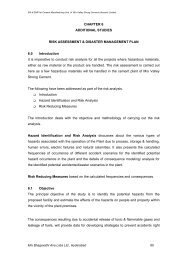
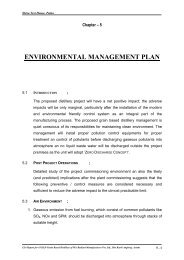
![a]ÝĖ^į %XĮ[ýįV - Pollution Control Board, Assam](https://img.yumpu.com/50573985/1/190x245/ayei-xiyiv-pollution-control-board-assam.jpg?quality=85)
